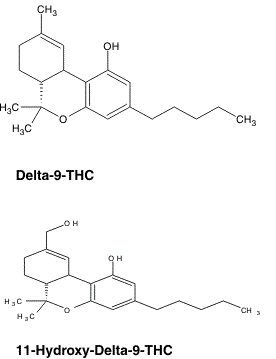I like smoking d8, d9, and d10 THC. I feel like they all get me very stoned, and other factors seem to control the nature of the high. I know that all three can cause you to fail correctional/employment drug tests, and all the scientific literature I have read show THC blood concentrations based on d9 THC.
Heating is a process that can change the chemistry of THC, and I was wondering how this affected d8, d9, d10 conversion. Does d8 reclaim start turning into d9?
Blood is the chemical environment that THC is in when it is absorbed through inhalation. Blood has a very specific pH, and is very complex chemically and also very stable in normal circulation. I would think that d8 and d10 THC converts to d9 in the blood, or maybe in the liver.
Has anyone seen a d8 or d10 measurement of THC in a living animals blood?
It is my understanding that eating THC means the liver will process it, which actually releases hydroxy 11 into the blood stream not any form of THC. I believe cannabinoids only readily enter the blood stream when inhaled or absorbed transdermally. I know different legal bodies have tried to establish blood levels of THC but it/s very difficult. They tend to lean toward nanograms per milliliter when describing thc in the blood.

That is what I was thinking, is that something about the blood and/or the liver causes cannabinoids to convert to d9, since these chemical changes to things like 11 hydroxy require the double bonds to be in the d9 conformation.
When it comes to correctional/employment THC screens, there is a lot of non-specificity in the cheaper tests, but even the more expensive ones doing HPLC seem to be looking for d9, and they find it. Then this leads me to wonder if they are not being as careful as a lab doing cannabinoid potency tests all day long, so d8 and d10 come up as THC.
I’m not very knowledgeable about HPLC peaks and which are which cannabinoids, but I was wondering what d8 and d10 are often mistaken as? I recently read a thread here where d10 was being mistaken for cbc.
What I’m really wondering is if there is an experiment done which has a person or animal consume d8 THC, and then they measure d8 THC and d9 THC in the bloodstream and see if it remains d8 THC once it enters the body.
I’m wondering this, because if d8 becomes d9 in the body then the in vitro studies on affinity to CB1 & 2 receptors become irrelevant, and there are new implications on how d8 should be viewed and regulated.
back in '73 they didn’t do the blood work…but I imagine you’ll find this work cited for any study where they DID. Sci-Hub | Delta-8- and delta-9-tetrahydrocannabinol; Comparison in man by oral and intravenous administration. Clinical Pharmacology & Therapeutics, 14(3), 353–357 | 10.1002/cpt1973143353
you might find this review clears up most of your questions: https://bpspubs.onlinelibrary.wiley.com/doi/full/10.1111/bph.15865
You would be wrong (but that just means you learned something).
Liver makes analogous changes to D8 and D9
2 Likes
Lipid lymphatic system
Operational google search: pharmacodynamics of inhaled cannabinoids
You’re never going to get thc naked into “blood” solution.
It has to complex with surface protein or exterior surface on some sort of blood cell, ???
The speculation here is to the point of misdirection.
1 Like
M
So the folks injecting intra-venous ethanolic solutions to study the pharmacodynamics of thc are missing the point?
Something like that…those shot must b tempered with saline or detergent…as soon as the bolus dissapates by diffusion…the THC either detergent solubilized or stuck* to some plasma component makes its way to BBB.
The lipid lymphatic uptake…it is going in detergent solubilized by the “lipid” component.
The point is none really knows…please inform .
- Every cannabinoid binding study I have ever read uses Tween or some other detergent for solubilizing the neutral cannabinoid…
Linear Elamite has recently been decoded, so there is always hope.

